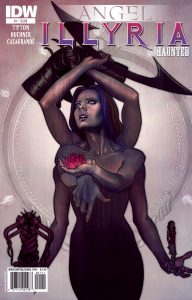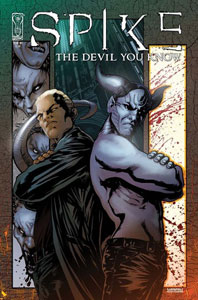Spike and Illyria go off on their own adventures toward the end of the period of IDW’s “Angel” ongoing series. Two four-issue miniseries — “Spike: The Devil You Know” and “Illyria: Haunted” – let us know what they’re up to, with varying degrees of entertainment value.
“Spike: The Devil You Know” (June-September 2010)
Spike joins forces with Eddie Hope, a blue horned devil who can shoot ice at his enemies similar to “X-Men’s” Iceman, to stop vampire Tansy Fry from opening a mini-Hellmouth. Despite getting four issues here in addition to a 12-part backup story in “Angel” Issues 28-39, Eddie – a creation of Bill Williams — remains an incomplete character. The vigilante is working his way through a list of L.A. vampires to kill, and Fry is the latest. We never get Eddie’s backstory.
Spike knows Tansy Fry from the old days; she was the Master’s favorite hench-vamp before Darla came along. She’s known for cutting swaths through towns, leaving way more corpses than she or her followers can feed on. It seems like she should’ve been staked by a fellow vampire long ago, as killing that many people is an invitation for humans to declare war on vampires; bloodsuckers fare much better if they kill more sparingly.
I think the banter between Spike and Eddie is supposed to propel “The Devil You Know,” but Williams doesn’t have Spike’s speaking rhythms quite right and the humor is limp – such as Eddie’s tail ripping holes in his pants when he transforms into devil form, or the duo debating which of them smells worse.
The art from Chris Cross (pencils) and Marc Deering (inks) is worth noting because it’s so different. The artists give us a feral, monstrous-looking Spike when he transforms into vamp-face, somewhat like Ryan Sook’s work on the classic Dark Horse comics, but with less grittiness.
Eddie’s not such a bad character that he couldn’t be integrated into Team Spike, which will finally return for the “Spike” eight-issue series, but he doesn’t. This is the end of his story, which has too many pages and not enough exploration of who he is.
2.5 stars

“Illyria: Haunted” (November 2010-March 2011)
This series marks the final step in Illyria’s psychological development from cruel immortal god to decent … for lack of a better word … human. (Technically, she’s an immortal god stuck in a human shell.) We’ll perhaps never know to what degree this lines up with what Joss Whedon would’ve done had “Angel” not been canceled after Season 5. The broad beats of her evil-to-good arc feel correct, and I can imagine Amy Acker speaking Illyria’s lines, although I imagine there would’ve been more twists and turns under Whedon’s pen.
In “Haunted,” written by Scott Tipton and Mariah Huehner, we learn how Illyria becomes a well-adjusted person who gladly helps Angel in the future-set portion of “The Wolf, the Ram and the Heart” (“Angel” Issues 39-44). She goes to the Deeper Well from “A Hole in the World” (5.15), then fights a huge, monstrous Old One that she has carelessly freed, while speaking to the beast (and herself and the reader) about why she wants to defeat it and keep humanity safe. This plays out similarly to when she fights her monstrous former pet in “Angel: Only Human,” Illyria’s road-trip tale with Gunn.

“Haunted’s” plot is predictable, but beautiful art by Elena Casagrande (pencils), Walter Trono (inks) and Ilaria Traversi (colors) enhance the script’s poetic quality. For instance, touching a gem in the Deeper Well triggers Illyria’s final transition to a human psyche (although she had been headed in that direction anyway), and her speech bubbles go from blue to white after the change.
As we see in flashback splash pages, Fred – and the feelings Fred inspired in her friends — is never far from Illyria’s mind. It’s a nice touch that even though none of Fred’s essence remains in her body (or “shell”), and even though Fred and Illyria never meet, Fred is the major catalyst in Illyria becoming a good person.
Similar to “Only Human,” the buildup and the banter are better than the plot. At the end of Issue 1, Spike – shown to be a much better listener than Angel — suggests that Illyria go to the Deeper Well to reconcile with her past. Issue 2 takes us through the steps required for Illyria to get to the Deeper Well. A funny highlight is when Spike and Illyria are waiting in line at a demonic post office. In a series of panels that show the line barely moving, Casagrande illustrates Illyria’s impatience and Spike’s stifled amusement. The humor in this issue is so good that I wonder why the other issues (particularly the last two) don’t try as much for laughs.
All told, IDW’s robust work with Illyria softens the blow of the truncation of Acker’s performance and Whedon’s writing of the character. More good news: We’re not done with Illyria yet; she’ll make some appearances in the canonical Dark Horse comics.
4 stars
Click here for an index of all of John’s “Buffy” and “Angel” reviews.

